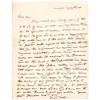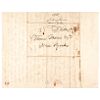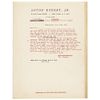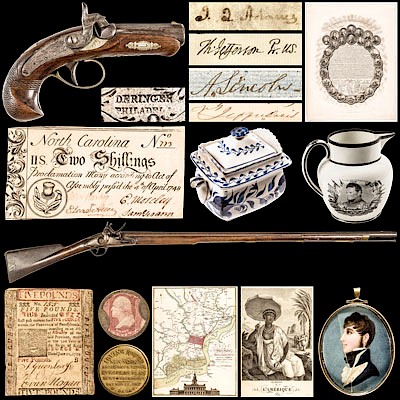1815 David D. Porter ALS Re: Robert Fulton's 1st Steam Powered Warship Demologos
Lot 82
Categories
Estimate:
$6,000 - $8,000
Absentee vs Live bid
Two ways to bid:
- Leave a max absentee bid and the platform will bid on your behalf up to your maximum bid during the live auction.
- Bid live during the auction and your bids will be submitted real-time to the auctioneer.
Bid Increments
| Price | Bid Increment |
|---|---|
| $0 | $10 |
| $200 | $20 |
| $300 | $25 |
| $500 | $50 |
| $1,000 | $100 |
| $2,000 | $200 |
| $3,000 | $250 |
| $5,000 | $500 |
| $10,000 | $1,000 |
| $20,000 | $2,000 |
| $30,000 | $2,500 |
| $50,000 | $5,000 |
| $100,000 | $10,000 |
| $200,000 | $20,000 |
| $300,000 | $25,000 |
| $500,000 | $50,000 |
About Auction
By Early American History Auctions
Oct 19, 2019
Set Reminder
2019-10-19 12:00:00
2019-10-19 12:00:00
America/New_York
Bidsquare
Bidsquare : Historic Autographs-Currency-Political-Americana-Militaria-Guns
https://www.bidsquare.com/auctions/early-american-history-auctions/historic-autographs-currency-political-americana-militaria-guns-4513
326 Lots of Rare, Historic Autographs, Americana, Civil War Era, George Washington, Abraham Lincoln, Black History, Revolutionary War Era, Colonial America, Federal Period, War of 1812, Colonial Currency, Indian Peace Medals & more... Early American History Auctions auctions@earlyamerican.com
326 Lots of Rare, Historic Autographs, Americana, Civil War Era, George Washington, Abraham Lincoln, Black History, Revolutionary War Era, Colonial America, Federal Period, War of 1812, Colonial Currency, Indian Peace Medals & more... Early American History Auctions auctions@earlyamerican.com
- Lot Description
Autographs
1815 Commodore David Porter's Autographed Letter Regarding Robert Fulton's First Steam Powered Warship the "Demologos" The Worlds First Steam Engine Warship!
DAVID PORTER (February 1, 1780 - March 3, 1843). United States Navy officer with the rank of Captain and the honorary title of Commodore. Porter commanded a number of U.S. naval ships, including the famous USS Constitution and saw service in the First Barbary War, the War of 1812, and in the West Indies.
July 29, 1815-Dated War of 1812 Era, Autograph Letter Signed, "D. Porter" as Commodore of the Navy, written at Washington, to Thomas Morris Esq., 1 page, measuring 7.75" x 10", Choice Extremely Fine. Sent with Integral Postal Mail Cover to: Thomas Morris Esqr. - New York" and with Free Franked: "D Porter N(ava)L Comd" at the upper right. This Letter, written fully by the hand of David Porter, is regarding the vessel "Demologos," which was designed to a unique pattern by Robert Fulton, and was renamed "Fulton" after his death, being the First Warship to be Propelled by a Steam Engine.
Renamed, "Fulton the 1st" upon Robert Fulton's death in February of 1815, by the time she was completed, the War of 1812 for which Demologos had been built had ended. She saw only One Day of active service, when she carried President James Monroe on a tour of New York Harbor. A two-masted lateen rig was added by the orders of her first Commander, Captain David Porter.
On March 9th, 1814, the United States Congress authorized the construction of a Steam Warship to be designed by Robert Fulton, a pioneer of commercial steamers in North America. The construction of the ship began on June 20, 1814, at the civilian yard of Adam and Noah Brown, and the ship was launched on October 29th. After sea trials she was delivered to the United States Navy in June 1816. The ship was never formally named, although Robert Fulton christened it "Demologos" or "Demologus," though following his death in February 1815, the ship was named "Fulton the 1st".
She was a wooden floating battery built to defend New York Harbor from the British Royal Navy during the War of 1812. The vessel was designed to a unique pattern by Robert Fulton (November 14, 1765 - February 24, 1815). Because of the prompt end of the War of 1812, the ship never saw action, and there was never another like her built. From 1815 to 1822, he was a member of the Board of Navy Commissioners in Washington, but then gave up this post to command the expedition for suppressing piracy in the West Indies (1823-25). Here, Commodore David Porter, her First Captain and Commander, suggests his approval for going forwards with the Fulton design.
By the time she was completed, the War of 1812 against the British, for which Demologos had been built had ended. She saw only one day of active service, when she carried President James Monroe on a tour of New York Harbor. A two-masted lateen rig was added by the orders of her first Commander, Captain David Porter. In 1821 her armament and machinery were removed. The remainder of her career was spent laid up in reserve; after 1825 she served as the floating barracks for Brooklyn Navy Yard. She came to an end on June 4th, 1829 in a gunpowder explosion. This historic content U.S. Naval Letter is written by its First Commander, Captain David Porter. It reads, in part:
"Dear Sir --- I have received your interesting favor of the 20th and by now to return you my sincere thanks for the information in contains. I have shown it to Comr. Thayers and he, as well as myself, accords fully with you as to the course that should be pursued with respect to the Fulton the 1st.
Thus far the experiment has equaled our most sanguine expectations, and we should not cease until we make it compleat. The President and all the heads of the Departments are now absent from this place, nothing in regard to that vessal can be done until they return, when I shall have every effort to carry your views into execution, and shall be happy to favor the virtues of my friend Lewis in which I shall have the aid of Comr (Commander) Th (Thayers) -- be pleased to accept my best wishes and believe me to be with sincere respect and esteem -- Your obdt. Humble Servt. - (Signed) D. Porter".
Docket reads, in full: "1815 - July 29 - Comm - Dav Porter".
Normal folds and light age toning, otherwise very fine condition. (Accompanied by a typed transcription.) Read much more regarding this item online at: EarlyAmerican.com
An outstanding historic content, piece of American Naval History and regarding the Robert Fulton Steam Powered Warship "Demologos," which was the First Warship to be Propelled by a Steam Engine!
See: Canney, Donald L. The Old Steam Navy, Volume One: Frigates, Sloops, and Gunboats 1815-1885. Annapolis, Maryland: Naval Institute Press, 1990. ISBN 0-87021-004-1
Lambert, Andrew "The Introduction of Steam" in Gardiner (ed) Steam, Steel and Shellfire: The Steam Warship 1815-1905, Conway, London 1992. ISBN 0-85177-608-6
"Fulton", U.S. Navy Historical Center, retrieved 25 June 2007.
The Robert Fulton designed Naval Warship "Demologos" had an entirely unique and innovative design. As a Catamaran, her paddlewheel was sandwiched between two hulls. Each hull was constructed 5 ft (1.5 m) thick for protection against gunfire and her Steam Engine, which was mounted below the waterline in one of the hulls, was capable of giving 5.5 knots (10.2 km/h) speed in favorable conditions.
Although designed to carry 30 32-pounder guns, 24 port and starboard, 6 fore and aft, the Navy had trouble acquiring sufficient guns, and a varying number were mounted while in actual service. Demologos was also fitted for two 100-pounder Columbiads, one mounted fore and another aft, these weapons were never actually furnished to the vessel.
The resulting vessel differed greatly from this early proposal. Robert Fulton's design solved several of the problems inherent in warships powered by paddlewheels which led to the adoption of the paddle-steamer as an effective warship in following decades. By placing the paddlewheel centrally, sandwiched between two hulls, Fulton protected it from gunfire; this design also allowed the ship to mount a full broadside of guns.
The steam engine offered the prospect of tactical advantage against sail-powered warships. In a calm, sailing ships depended on the manpower of their crews to tow the ship from the boats, or to kedge with anchors. Demologos, with steam, might have found it easy to outmaneuver a ship-of-the-line in calm weather.
The innovative construction and steam power also fundamentally limited the role Demologos could fill. With an unreliable engine and a hull unsuited to seaways, Demologos was unable to travel on the high seas. The United States Navy planned to build a number of similar steam batteries, but none of these plans got off the drawing board until the USS Fulton of 1837. A number of European navies also considered acquiring the Demologos, but these inquiries came to nought.
Demologos had an entirely unique and innovative design. A catamaran, her paddlewheel was sandwiched between two hulls. Each hull was constructed 5 ft (1.5 m) thick for protection against gunfire. The steam engine, mounted below the waterline in one of the hulls, was capable of giving 5.5 knots (10.2 km/h) speed in favorable conditions.
Although designed to carry 30 32-pounder guns, 24 port and starboard, 6 fore and aft, the Navy had trouble acquiring sufficient guns, and a varying number were mounted while in actual service. Demologos was also fitted for two 100-pounder Columbiads, one mounted fore and another aft, these weapons were never actually furnished to the vessel.
Three-view of Demologos as originally portrayed to the US government. The resulting vessel differed greatly from this early proposal. Fulton's design solved several of the problems inherent in warships powered by paddlewheels which led to the adoption of the paddle-steamer as an effective warship in following decades. By placing the paddlewheel centrally, sandwiched between two hulls, Fulton protected it from gunfire; this design also allowed the ship to mount a full broadside of guns.
The steam engine offered the prospect of tactical advantage against sail-powered warships. In a calm, sailing ships depended on the manpower of their crews to tow the ship from the boats, or to kedge with anchors. Demologos, with steam, might have found it easy to outmaneuver a ship-of-the-line in calm weather.
The innovative construction and steam power also fundamentally limited the role Demologos could fill. With an unreliable engine and a hull unsuited to seaways, Demologos was unable to travel on the high seas. The United States Navy planned to build a number of similar steam batteries, but none of these plans got off the drawing board until the USS Fulton of 1837. A number of European navies also considered acquiring the Demologos, but these inquiries came to nought.
The Demologos was ultimately a dead end in the introduction of steam power to the warship. Armed paddle steamers proliferated in the 1830s and 40s as armed tugs and transports. During the Civil War, the United States Navy operated a number of iron clad steam-powered paddle-wheel gunboats as a part of the Mississippi River Squadron. Known as City-class ironclad gunboats as they were named after cities on the Mississippi River or its tributaries, these ships utilized a double-hulled configuration similar to Fulton's design, with the paddle wheel in the center. The wheel was protected by armored plate, allowing full broad-sides, as well as bow and stern shots.
An example, the USS Cairo, is on display at the Vicksburg National Military Park. Paddle-wheel propulsion, more usually side-paddle configurations, in military use continued until World War II with the USS Wolverine and USS Sable training aircraft carriers. These designs were typically limited to use in the brown-water navy or on large lakes.
Steam-powered paddle wheel propulsion would ultimately be eclipsed by the introduction of the screw propeller in the 1840s, enabling steam-powered version of the ship of the line and the frigate before steam power was properly adapted for use in a blue water navy.
- Shipping Info
-
Early American provides in-house worldwide shipping. Please contact us directly if you have questions about your specific shipping requirements.
-
- Buyer's Premium



 EUR
EUR CAD
CAD AUD
AUD GBP
GBP MXN
MXN HKD
HKD CNY
CNY MYR
MYR SEK
SEK SGD
SGD CHF
CHF THB
THB














